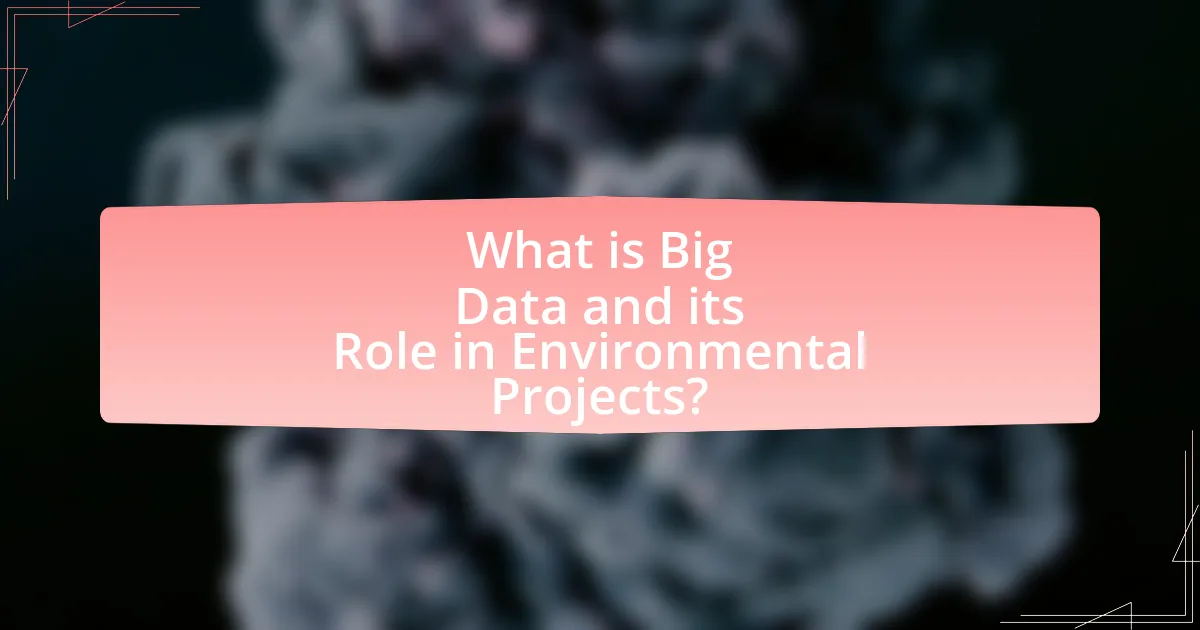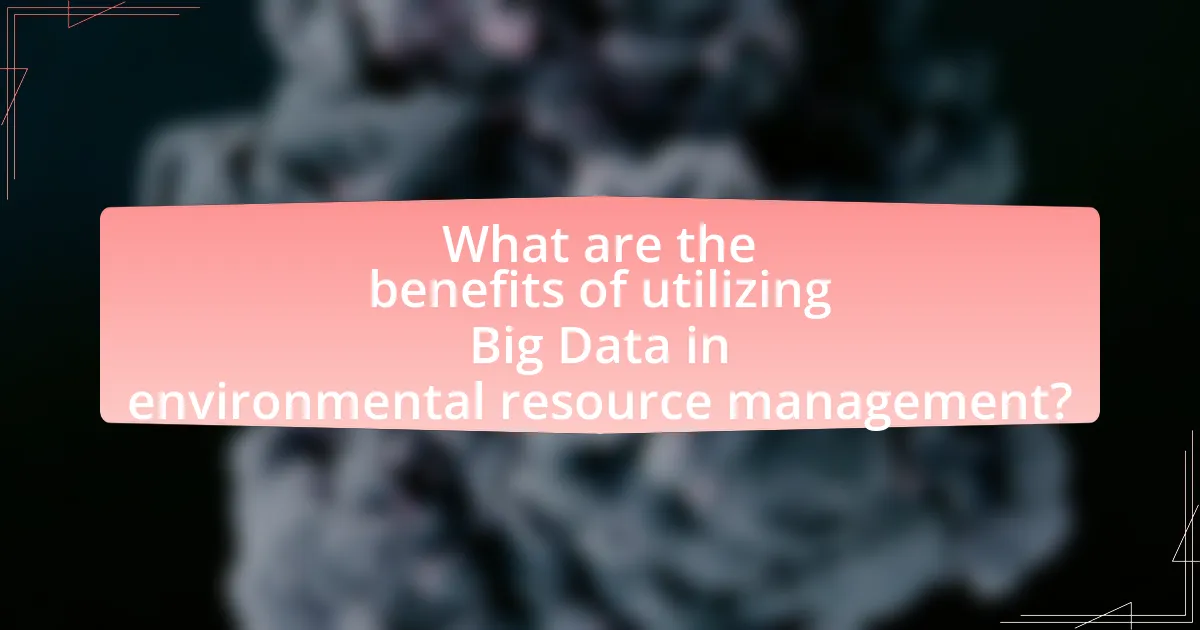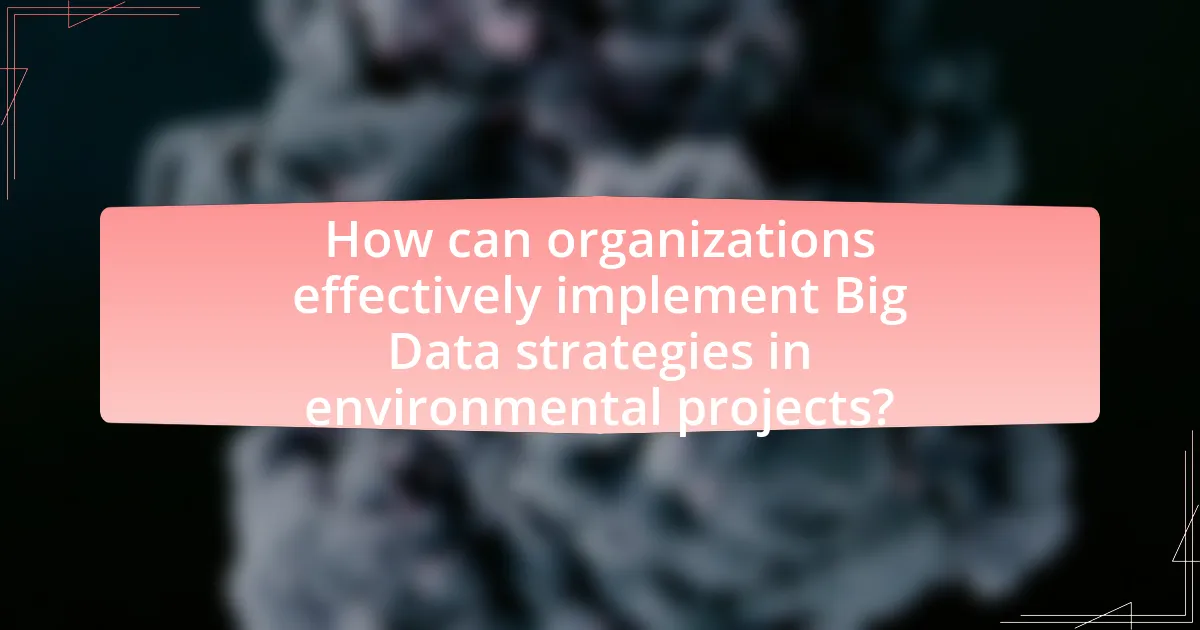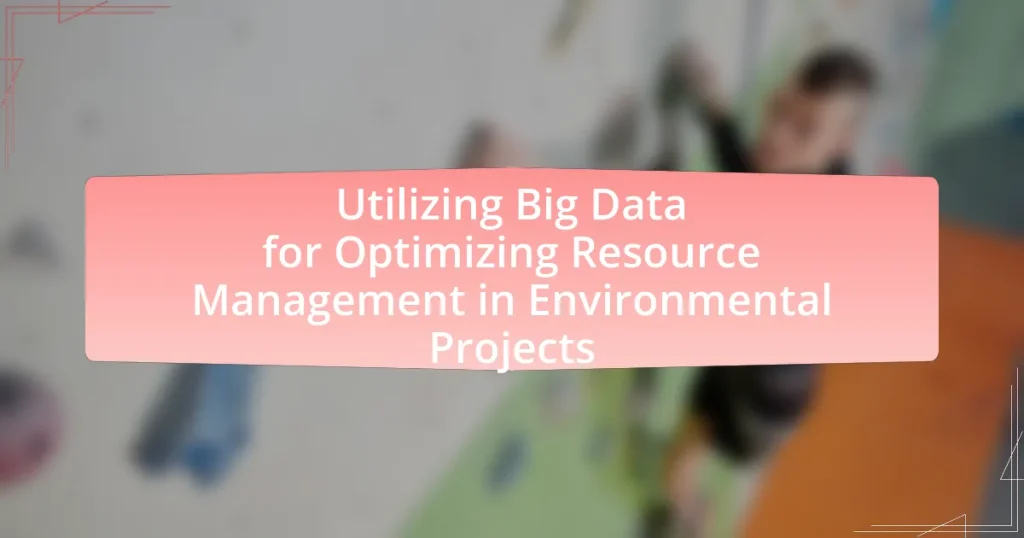Big Data refers to the extensive volumes of structured and unstructured data generated from various sources, which can be analyzed to enhance decision-making in environmental projects. This article explores the critical role of Big Data in optimizing resource management, highlighting its applications in monitoring environmental changes, predicting natural disasters, and improving sustainability practices. Key characteristics of Big Data, such as volume, velocity, variety, veracity, and value, are discussed, along with the differences between Big Data and traditional data. The article also addresses the challenges faced in resource management, the benefits of effective resource allocation, and the future trends in Big Data applications, including the integration of artificial intelligence and emerging technologies.

What is Big Data and its Role in Environmental Projects?
Big Data refers to the vast volumes of structured and unstructured data generated from various sources, including sensors, satellites, and social media, which can be analyzed for insights. In environmental projects, Big Data plays a crucial role by enabling the monitoring of environmental changes, predicting natural disasters, and optimizing resource management. For instance, the integration of Big Data analytics in climate modeling has improved the accuracy of weather forecasts, allowing for better preparedness against extreme weather events. Additionally, organizations like the World Resources Institute utilize Big Data to track deforestation and assess water quality, demonstrating its effectiveness in promoting sustainable practices and informed decision-making in environmental management.
How is Big Data defined in the context of environmental management?
Big Data in the context of environmental management is defined as the vast volumes of structured and unstructured data generated from various sources, including sensors, satellite imagery, and social media, that can be analyzed to improve decision-making and resource management. This data encompasses information on climate patterns, pollution levels, biodiversity, and resource consumption, enabling stakeholders to identify trends, predict outcomes, and implement effective strategies for sustainability. For instance, a study by the World Economic Forum highlights that utilizing Big Data analytics can enhance the efficiency of water resource management by up to 30%, demonstrating its critical role in optimizing environmental projects.
What are the key characteristics of Big Data relevant to environmental projects?
The key characteristics of Big Data relevant to environmental projects include volume, velocity, variety, veracity, and value. Volume refers to the massive amounts of data generated from various sources such as satellite imagery, sensor networks, and social media, which can exceed petabytes. Velocity indicates the speed at which this data is generated and processed, allowing for real-time monitoring of environmental changes. Variety encompasses the diverse types of data, including structured data from databases and unstructured data from text and images, which can provide comprehensive insights into environmental conditions. Veracity highlights the reliability and accuracy of the data, which is crucial for making informed decisions in environmental management. Lastly, value signifies the actionable insights derived from analyzing Big Data, which can lead to improved resource management and sustainability practices. These characteristics enable effective monitoring, analysis, and decision-making in environmental projects, ultimately contributing to better resource management and conservation efforts.
How does Big Data differ from traditional data in environmental contexts?
Big Data differs from traditional data in environmental contexts primarily through its volume, velocity, variety, and veracity. Traditional data typically involves structured datasets collected at specific intervals, often limited in scope and size, whereas Big Data encompasses vast amounts of unstructured and semi-structured data generated in real-time from diverse sources such as sensors, satellites, and social media. For instance, environmental monitoring can leverage Big Data analytics to process millions of data points from IoT devices, enabling more accurate predictions of climate patterns and resource usage. This capability allows for enhanced decision-making and resource management, as evidenced by studies showing that Big Data applications can improve water resource management efficiency by up to 30%.
Why is optimizing resource management crucial for environmental projects?
Optimizing resource management is crucial for environmental projects because it enhances efficiency and sustainability in resource use. Effective resource management minimizes waste, reduces costs, and maximizes the impact of environmental initiatives. For instance, a study by the World Resources Institute found that optimizing water usage in agricultural projects can lead to a 30% reduction in water consumption while maintaining crop yields. This demonstrates that strategic resource management not only conserves vital resources but also supports the overall goals of environmental sustainability.
What challenges do environmental projects face in resource management?
Environmental projects face significant challenges in resource management, primarily due to data integration, stakeholder engagement, and funding limitations. Data integration issues arise from the need to consolidate diverse datasets from various sources, which can hinder effective decision-making. Stakeholder engagement is critical, as conflicting interests among local communities, governments, and organizations can complicate project implementation. Additionally, funding limitations often restrict the scope and scale of environmental initiatives, making it difficult to achieve long-term sustainability. These challenges are well-documented; for instance, a study by the World Resources Institute highlights that inadequate data management and stakeholder collaboration are key barriers to successful resource management in environmental projects.
How can effective resource management impact environmental sustainability?
Effective resource management significantly enhances environmental sustainability by optimizing the use of natural resources, thereby reducing waste and minimizing ecological footprints. For instance, efficient water management practices can lead to a reduction in water consumption by up to 30%, as demonstrated in various agricultural studies, which in turn helps preserve local ecosystems and biodiversity. Additionally, effective resource management can facilitate the transition to renewable energy sources, decreasing reliance on fossil fuels and lowering greenhouse gas emissions. Research indicates that implementing data-driven resource management strategies can lead to a 20% increase in energy efficiency in industrial operations, further supporting sustainability goals.
What are the primary applications of Big Data in resource management?
The primary applications of Big Data in resource management include predictive analytics, real-time monitoring, and optimization of resource allocation. Predictive analytics utilizes historical data to forecast future resource needs, enabling organizations to plan effectively and reduce waste. Real-time monitoring involves the continuous collection and analysis of data from various sources, allowing for immediate adjustments in resource usage based on current conditions. Optimization of resource allocation leverages algorithms and data analysis to ensure that resources are distributed efficiently, minimizing costs and maximizing effectiveness. These applications are supported by advancements in data processing technologies and the increasing availability of data from IoT devices, which enhance decision-making processes in environmental projects.
How does Big Data enhance decision-making in environmental projects?
Big Data enhances decision-making in environmental projects by providing comprehensive insights through the analysis of vast datasets, which allows for more informed and timely decisions. For instance, environmental monitoring systems utilize Big Data to track changes in climate patterns, pollution levels, and biodiversity, enabling project managers to identify trends and make proactive adjustments. A study by the World Economic Forum highlights that organizations leveraging Big Data analytics can improve resource allocation efficiency by up to 30%, demonstrating the tangible benefits of data-driven decision-making in environmental initiatives.
What tools and technologies are used to analyze Big Data in this field?
Tools and technologies used to analyze Big Data in optimizing resource management for environmental projects include Apache Hadoop, Apache Spark, and machine learning algorithms. Apache Hadoop enables distributed storage and processing of large datasets, while Apache Spark provides fast data processing capabilities and supports real-time analytics. Machine learning algorithms, such as decision trees and neural networks, are employed to derive insights from complex data patterns. These tools facilitate efficient data handling and analysis, which is crucial for making informed decisions in environmental resource management.
How can Big Data be utilized to improve efficiency in resource allocation?
Big Data can be utilized to improve efficiency in resource allocation by enabling data-driven decision-making through real-time analytics and predictive modeling. Organizations can analyze vast datasets to identify patterns and trends in resource usage, allowing them to allocate resources more effectively based on demand forecasts. For instance, a study by McKinsey & Company found that companies leveraging Big Data analytics can reduce operational costs by 10-25% by optimizing resource distribution. This data-driven approach ensures that resources are allocated where they are most needed, minimizing waste and enhancing overall project efficiency.
What methods are effective for analyzing resource usage data?
Effective methods for analyzing resource usage data include statistical analysis, machine learning algorithms, and data visualization techniques. Statistical analysis allows for the identification of trends and patterns in resource consumption, while machine learning algorithms can predict future usage based on historical data. Data visualization techniques, such as dashboards and graphs, facilitate the interpretation of complex datasets, making it easier to communicate findings. These methods are supported by research indicating that organizations employing advanced analytics can achieve up to a 20% reduction in resource waste, thereby enhancing overall efficiency in environmental projects.
How can predictive analytics optimize future resource management?
Predictive analytics can optimize future resource management by analyzing historical data to forecast demand and resource allocation needs. This approach enables organizations to anticipate shortages or surpluses, allowing for proactive adjustments in resource distribution. For instance, a study by IBM found that companies using predictive analytics improved their resource utilization by up to 20%, demonstrating the effectiveness of data-driven decision-making in managing resources efficiently. By leveraging algorithms and machine learning, predictive analytics provides actionable insights that enhance planning and operational efficiency in environmental projects.

What are the benefits of utilizing Big Data in environmental resource management?
Utilizing Big Data in environmental resource management enhances decision-making, improves efficiency, and fosters sustainability. Big Data enables the analysis of vast datasets from various sources, such as satellite imagery and sensor networks, allowing for real-time monitoring of environmental conditions. For instance, a study by the World Economic Forum highlights that data analytics can optimize water usage in agriculture, potentially saving up to 30% of water resources. Additionally, predictive analytics derived from Big Data can forecast environmental changes, aiding in proactive management strategies. This capability is crucial for addressing challenges like climate change and resource depletion, ultimately leading to more informed and effective environmental policies.
How does Big Data contribute to cost savings in environmental projects?
Big Data contributes to cost savings in environmental projects by enabling more efficient resource management and decision-making. By analyzing large datasets, organizations can identify patterns and trends that lead to optimized operations, such as reducing waste and improving energy efficiency. For instance, a study by the World Economic Forum found that utilizing Big Data analytics in energy management can lead to cost reductions of up to 30% by predicting energy consumption patterns and optimizing supply chains. Additionally, real-time data monitoring allows for proactive maintenance of equipment, which can prevent costly breakdowns and extend asset life.
What specific examples demonstrate cost reduction through Big Data?
Big Data has led to significant cost reductions in various sectors, particularly in environmental projects. For instance, the city of Los Angeles utilized Big Data analytics to optimize its water management system, resulting in a 20% reduction in water waste and saving approximately $10 million annually. Similarly, the energy sector has seen cost savings through predictive maintenance; General Electric reported that using Big Data analytics in their wind turbine operations reduced maintenance costs by 10-15%, translating to millions in savings. Additionally, the use of satellite data for precision agriculture has enabled farmers to reduce fertilizer costs by up to 30%, demonstrating how Big Data can enhance resource efficiency and lower operational expenses.
How can Big Data improve project timelines and efficiency?
Big Data can improve project timelines and efficiency by enabling data-driven decision-making and predictive analytics. By analyzing vast amounts of data, project managers can identify potential risks and bottlenecks early, allowing for proactive adjustments to schedules and resource allocation. For instance, a study by McKinsey & Company found that organizations leveraging Big Data analytics can reduce project time by 20-30% through improved forecasting and resource management. This capability not only streamlines operations but also enhances collaboration among stakeholders, leading to more efficient project execution.
What role does Big Data play in enhancing stakeholder engagement?
Big Data plays a crucial role in enhancing stakeholder engagement by providing actionable insights that inform decision-making and foster communication. By analyzing large datasets, organizations can identify stakeholder preferences, behaviors, and concerns, which allows for tailored engagement strategies. For instance, a study by McKinsey & Company found that companies leveraging data analytics to understand customer needs saw a 20% increase in stakeholder satisfaction. This data-driven approach enables organizations to proactively address issues, improve transparency, and build trust, ultimately leading to more effective collaboration in environmental projects.
How can data visualization tools improve communication with stakeholders?
Data visualization tools enhance communication with stakeholders by transforming complex data into easily understandable visual formats. These tools allow stakeholders to quickly grasp key insights, trends, and patterns, facilitating informed decision-making. For instance, a study by the Data Visualization Society found that visual data representation can increase comprehension by up to 80%, making it easier for stakeholders to engage with the information presented. By using charts, graphs, and interactive dashboards, data visualization tools foster transparency and collaboration, ensuring that all parties have a clear understanding of project metrics and outcomes.
What are the benefits of transparency in resource management data?
Transparency in resource management data enhances accountability, fosters trust among stakeholders, and improves decision-making processes. By making data accessible and understandable, organizations can ensure that resource allocation is scrutinized, leading to more responsible use of resources. For instance, a study by the World Resources Institute found that transparent data practices can lead to a 20% increase in stakeholder engagement in environmental projects, as stakeholders feel more informed and involved. This increased engagement often results in better collaboration and more effective resource management strategies.
What are the potential risks and challenges of using Big Data?
The potential risks and challenges of using Big Data include data privacy concerns, data quality issues, and the complexity of data integration. Data privacy concerns arise from the collection and analysis of personal information, which can lead to breaches and misuse, as highlighted by incidents like the Cambridge Analytica scandal. Data quality issues can result from inaccurate, incomplete, or outdated data, which can compromise decision-making processes; a study by IBM found that poor data quality costs organizations an average of $15 million annually. Additionally, the complexity of integrating diverse data sources can lead to technical challenges and increased costs, as organizations may struggle to harmonize data from various platforms and formats.
How can data privacy concerns affect the use of Big Data in environmental projects?
Data privacy concerns can significantly hinder the use of Big Data in environmental projects by limiting data collection and sharing practices. When individuals or organizations fear that their personal information may be exposed or misused, they may be less willing to participate in data-gathering initiatives, which are crucial for effective environmental monitoring and resource management. For instance, regulations like the General Data Protection Regulation (GDPR) impose strict guidelines on data handling, compelling organizations to implement costly compliance measures that can slow down project timelines and increase operational complexity. Consequently, these privacy concerns can lead to incomplete datasets, reducing the accuracy and effectiveness of analyses aimed at optimizing resource management in environmental projects.
What strategies can mitigate the risks associated with Big Data usage?
Implementing data governance frameworks is a key strategy to mitigate the risks associated with Big Data usage. These frameworks establish policies and standards for data management, ensuring data quality, security, and compliance with regulations such as GDPR. For instance, organizations that adopt data governance can reduce data breaches by up to 50%, as reported by the Ponemon Institute in their 2020 Cost of a Data Breach Report. Additionally, employing advanced analytics and machine learning can enhance data accuracy and predictive capabilities, further minimizing risks related to decision-making based on flawed data.

How can organizations effectively implement Big Data strategies in environmental projects?
Organizations can effectively implement Big Data strategies in environmental projects by integrating advanced analytics and data management systems to enhance decision-making processes. This involves collecting diverse data sets, such as satellite imagery, sensor data, and social media inputs, to gain comprehensive insights into environmental conditions. For instance, the use of predictive analytics can help forecast environmental changes, enabling proactive measures. A study by the World Economic Forum highlights that organizations leveraging Big Data can improve resource allocation by up to 30%, demonstrating the tangible benefits of data-driven strategies in optimizing environmental management.
What best practices should organizations follow when integrating Big Data?
Organizations should follow best practices such as establishing clear objectives, ensuring data quality, and implementing robust data governance when integrating Big Data. Clear objectives guide the integration process, helping organizations focus on specific outcomes, such as improving resource management in environmental projects. Ensuring data quality is crucial, as accurate and reliable data leads to better decision-making; studies show that poor data quality can cost organizations up to 30% of their revenue. Robust data governance frameworks help manage data access, security, and compliance, which are essential for maintaining trust and integrity in data usage.
How can organizations ensure data quality and accuracy?
Organizations can ensure data quality and accuracy by implementing robust data governance frameworks that include standardized data collection processes, regular data audits, and validation techniques. These frameworks help maintain consistency and reliability in data management practices. For instance, a study by the Data Management Association (DAMA) highlights that organizations with established data governance see a 30% improvement in data accuracy. Additionally, employing automated data cleansing tools can significantly reduce errors and enhance data integrity, as evidenced by research from Gartner, which indicates that organizations using such tools experience a 40% decrease in data-related issues.
What training and resources are necessary for staff to utilize Big Data effectively?
Staff must undergo training in data analytics, statistical methods, and data visualization to utilize Big Data effectively. This training equips employees with the skills to interpret complex datasets, apply analytical techniques, and present findings in a comprehensible manner. Additionally, access to resources such as advanced analytics software (e.g., Hadoop, Spark), cloud computing platforms, and data management tools is essential. These resources enable staff to process large volumes of data efficiently and derive actionable insights. Research indicates that organizations investing in employee training and the right technological resources see a 20% increase in productivity related to data-driven decision-making.
What are the future trends in Big Data for environmental resource management?
Future trends in Big Data for environmental resource management include enhanced predictive analytics, real-time monitoring, and integration of artificial intelligence. Enhanced predictive analytics will allow for more accurate forecasting of environmental changes, enabling proactive management strategies. Real-time monitoring through IoT devices will facilitate immediate data collection and analysis, improving response times to environmental issues. The integration of artificial intelligence will enable more sophisticated data processing and decision-making, optimizing resource allocation and management. These trends are supported by the increasing availability of data sources and advancements in computational technologies, which enhance the capacity to analyze large datasets effectively.
How is artificial intelligence shaping the future of Big Data in this field?
Artificial intelligence is transforming the future of Big Data in environmental resource management by enhancing data analysis capabilities and enabling predictive modeling. AI algorithms can process vast amounts of environmental data more efficiently than traditional methods, allowing for real-time insights and improved decision-making. For instance, machine learning techniques can identify patterns in climate data, leading to better resource allocation and management strategies. According to a study published in the journal “Environmental Science & Technology,” AI-driven analytics can increase the accuracy of resource management predictions by up to 30%, demonstrating its significant impact on optimizing environmental projects.
What emerging technologies are likely to influence Big Data applications?
Emerging technologies likely to influence Big Data applications include artificial intelligence (AI), machine learning (ML), the Internet of Things (IoT), and blockchain. AI and ML enhance data analysis capabilities, enabling predictive analytics and real-time decision-making, which are crucial for optimizing resource management in environmental projects. The IoT facilitates the collection of vast amounts of data from various sensors and devices, providing valuable insights into environmental conditions and resource usage. Blockchain technology offers secure and transparent data management, ensuring data integrity and trustworthiness in Big Data applications. These technologies collectively drive innovation and efficiency in managing environmental resources.
What practical steps can organizations take to start utilizing Big Data?
Organizations can start utilizing Big Data by implementing a structured data strategy that includes data collection, storage, analysis, and visualization. First, they should identify relevant data sources, such as environmental sensors, satellite imagery, and social media, to gather data pertinent to their projects. Next, organizations must invest in scalable storage solutions, like cloud platforms, to handle large volumes of data efficiently.
Following data storage, organizations should employ analytical tools and techniques, such as machine learning algorithms, to extract insights from the data. For instance, predictive analytics can forecast resource needs and optimize allocation in environmental projects. Finally, organizations should utilize data visualization tools to present findings clearly, enabling stakeholders to make informed decisions based on the insights derived from Big Data.
These steps are supported by the fact that organizations leveraging Big Data can improve operational efficiency by up to 30%, as reported by the McKinsey Global Institute.

